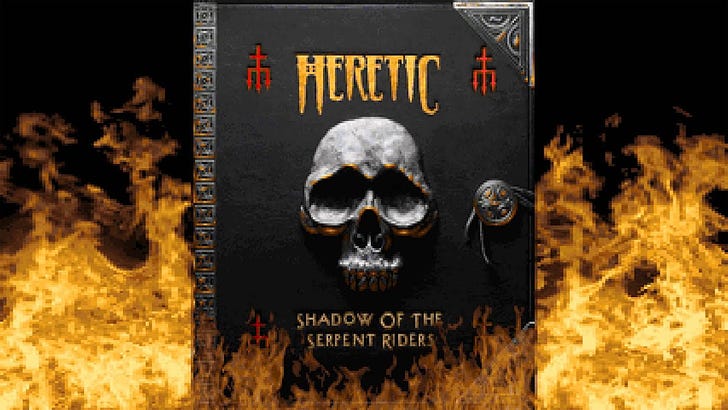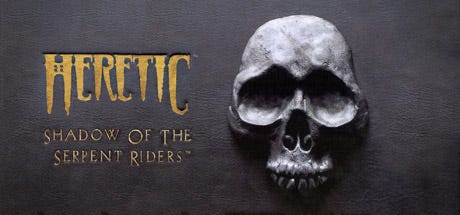Retro spotlight: Heretic
id wasn't alone in making first-person shooters with the DOOM Engine for very long, though, they did publish another company's effort, with one of their key figures producing.
This column is “Retro spotlight,” which exists mostly so I can write about whatever game I feel like even if it doesn’t fit into one of the other topics you find in this newsletter. Previous entries in this series can be found through this link.
When DOOM released in 1993, it changed everything. Wolfenstein 3D had been a major shock to the system, too, but DOOM was light years ahead of that game despite releasing in the next calendar year. Heretic was not the kind of leap forward that DOOM was, but it was the kind of game that could exist in a world where DOOM already did. Developed by Raven Software and published by id, with the DOOM Engine powering it all, Heretic was something of a throwback to id’s own Catacomb 3D, which was a fantasy-based first-person shooter featuring magical attacks and creatures befitting the context. It wasn’t Catacomb, though, but something else entirely, as Heretic was able to benefit from the kind of progress in the genre that id’s John Carmack had made in the previous few years, progress that moved the company from the engine powering Catacomb 3D and Wolfenstein 3D to the one that made DOOM possible.
On top of that, Heretic managed to move things forward for the genre a bit, by building on the work Carmack had already done. Heretic added consumable items and the ability to look up and down, which is not something that DOOM allowed for: the modified version of the DOOM Engine used for Heretic, however, did. Oh, and you could fly in Heretic.
Just like DOOM wasn’t truly 3D, but was instead a two-dimensional game viewed from a first-person perspective — a nifty and convincing trick of faux 3D, which is why you could play DOOM entirely from the topdown map screen if you wanted to — your character wasn’t really flying through the world of Heretic. But convincing programming tricks allowed for it to look that way, just like programming tricks allowed you to feel you were truly driving into the background in OutRun in the decade before, or truly turning that corner like in Super Mario Kart:
"I have to call out Chris Rhinehart, who was one of our programmers at the time. Kind of a funny story about the flying... it's so true, so many of these stories are these 'happy accidents...' Chris came up with the idea of moving the horizon line just up and down. It wasn't a real calculation of flying, it was a hack... That was such a big event for us, and that gave us our unique flavor."
The existence of Heretic also allowed id to show off the genius of their model. While they worked on DOOM II, which is something of an expansion of the more surreal and abstract concepts of the original DOOM rather than an entirely new, from-the-ground-up effort a la DOOM 3, John Romero spent time producing Heretic and working closely on that game. (Romero, it should be noted, was responsible for the more realistic early stages of the original DOOM, with the later, more hell-like levels designed by Sandy Peterson, who would make even more of those stages in every meaning of the word for DOOM II.) Carmack could then focus more on the next engine — not the slightly modified ones used for DOOM II and Heretic and so on, but the one that would power id’s own fantasy-based shooter, Quake, which would actually be in full, true 3D with real-time rendering instead of the faux 3D used by the DOOM Engine. Final DOOM, which followed DOOM II, was something of a midpoint of these two ideas: the existing engine was used to make another DOOM, with another studio doing the actual development work while id produced and Carmack focused elsewhere.
It was all impressive then, but remains pertinent to this day, as well, given that games are still released using modified versions of the DOOM Engine. Dominic Tarason celebrated DOOM’s 30th anniversary on Twitter by making a megathread — no hyperbole there, either — of standalone games utilizing the DOOM Engine.
It’s impossible to avoid comparisons to DOOM here, given the engine, the relative nascency of the genre and gameplay style, and the fact the level designer for so much of the original DOOM was producing Heretic, with id publishing, and so on. You still have colored keys to open doors, and monsters popping up behind you after invisible lines are crossed or switches pushed. You still have health and armor and an arsenal that includes analogs for a pistol, a chaingun, a chainsaw, and (sort of) a shotgun, since the crossbow does fire wide, albeit without the pinpoint devastation inherent to DOOM’s room-clearing marvel.
But Heretic, for all of the design choices borrowed from DOOM, still feels very much like its own thing. And not just because the lack of a true shotgun equivalent makes for a relatively slower pace to it all. The single-use items, such as the healing potions that you can store, make Heretic feel considerably different than DOOM, in terms of how you might approach a given area or your long-term plans. There are tomes that enhance your weapons for a spell, there’s the ability to look up and down that changes the nature of your relationship to some level design and the enemies hiding within its architecture, and the flying. There’s also the flying. And while the Necromancer Gauntlets are something of a chainsaw analog, it should also be pointed out that they are Necromancer Gauntlets, and deserve the respect that something named such merits. Whereas the basic staff is a replacement for DOOM’s fists — a desperation move when nothing else is left — the Gauntlets of the Necromancer fire off short-range, persistent electrical energy that will incinerate foes at close range. Difficult to use if you’re surrounded, sure, but absolutely brutal in one-on-one encounters, just like the chainsaw in DOOM.
Because of the setting and the more advanced engine, Heretic feels a little more like what Wolfenstein would end up becoming, at least briefly. Which is fitting, since Raven Software would end up making a Wolfenstein game in 2009, a sequel to Activision’s Return to Castle Wolfenstein, the development of which was overseen by id, and both of which used versions of the id Tech engine. Like with Heretic, that is a game imbued with plenty of fantasy elements and magical twists, though, the weaponry didn’t have to be an analog for anything you’d expect in a modern-setting FPS, because it was also that.
While Heretic is a little slower paced than DOOM, it’s still plenty fast by the standards of the day and really, since. While quick-moving first-person shooters influenced by DOOM have certainly made a resurgence on the independent (or at least, non-AAA scene), there was a period of time there were things were quite slow and even cumbersome: Heretic might not seem swift next to DOOM, but next to games that aren’t DOOM (or like, TimeSplitters 2), it moves plenty fast.
Heretic originally released as a three-episode game over shareware, which was id’s business model of the day, where your goal was, as the elf, Corvus, to exact vengeance for the death and destruction brought to his people by the magical Serpent Riders, which would eventually involve traveling through portals and sealing them to stop an attack of creatures from beyond that veil. Hey, I didn’t say everything was different than DOOM. About 15 months later the game would sell at retail as Heretic: Shadow of the Serpent Riders, with an additional two episodes.
This is the version of the game you can still buy today, in more ways than one. The DOS release of Heretic was the first and now still existing edition of the game: the one you can buy now through Steam or GOG has to run through DOSBox, even. Heretic did not end up on consoles like DOOM did, maybe owing to the fact that the consoles of the moment — the SNES, Sega’s 32X add-on — had a hard enough time running a complete, uncompromised version of DOOM, and that was significantly more popular than Heretic ever got to be. By the time the Playstation and Saturn were there for something like Heretic, the series had already moved on to its sequel, Hexen: Beyond Heretic, and it would take until 1998 for the “true” sequel, Heretic II, to come out. Hexen ended up being the one that received console ports — MAC OS, Windows, Playstation, Saturn, Nintendo 64 — while Heretic II only received ports to other computer platforms, likely owing to it running on a modified Quake II engine.
No one got around to remastering Heretic just yet, which might have to do with the rights issues surrounding the series. Heretic was published by id, as was Hexen and its expansion, Death King of the Dark Citadel, and its sequel, Hexen II. Heretic II, however, was published by Activision, as Raven was purchased by them in 1997. So, for years, the rights were split between two publishers — id (and its parent companies) made all of the Heretic and Hexen games they have the rights to available for purchase in the present, which is standard operating procedure for them, while Activision has kept Heretic II unavailable. Meaning it couldn’t be purchased on its own, it couldn’t be part of the kind of bundle that Steam loves to put together to let you buy the entire series for pennies, and it couldn’t be remastered and re-released, either, since it was an out-of-context sequel to a series that also wasn’t getting remastered given its own incomplete state.
Now, though, Microsoft has purchased Zenimax, which owns Bethesda which owns id, and they’ve also purchased Activision. Which is terrible for plenty of reasons we don’t need to get into here relating to monopolies and the flattening of the industry into fewer and fewer companies owned by a small number of conglomerations, but hey, on the singular bright side, all of Heretic’s rights are under one roof. So maybe instead of being relegated to the original editions of these games — or no edition at all, in the case of Heretic II — we’ll see a faithful remaster and re-release that includes long overdue ports to consoles along with quality of life features. Someone like Nightdive Studios has proven up to the task on many an occasion, so maybe, eventually, Heretic, Hexen, and the rest will get the treatment they deserve, and a second chance outside of the shadow of DOOM and Quake.
This newsletter is free for anyone to read, but if you’d like to support my ability to continue writing, you can become a Patreon supporter, or donate to my Ko-fi to fund future game coverage at Retro XP.





It's a pity that this fantasy branch of shooters never took off, other than the excellent Hexen 2, which is still one of the most stunning games made using the original Quake engine.